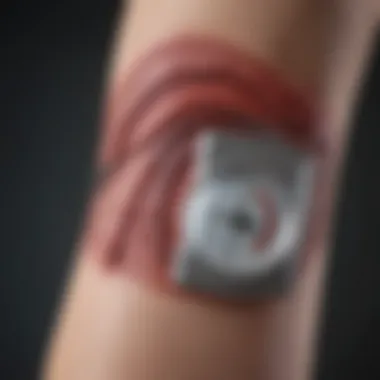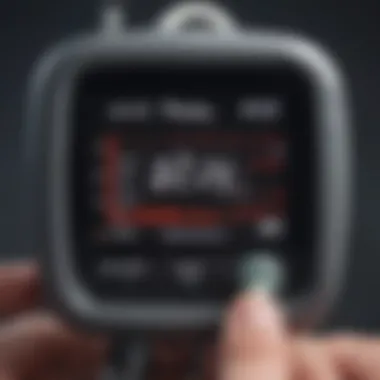Understanding Blood Pressure Measurement: A Comprehensive Guide


Intro
Blood pressure measurement is a fundamental aspect of health monitoring, both in clinical settings and for personal use. Understanding how to read blood pressure cuffs and what the numbers mean is crucial for making informed health decisions. This journey begins not just with the numbers on a sphygmomanometer but also with a grasp of physiology and measurement techniques.
In an era where hypertension is increasingly widespread, knowledge about blood pressure can empower individuals to take charge of their health. Thus, this guide aims to dissect the elements involved in blood pressure measurement, providing clarity on how to interpret the readings alongside their implications for overall well-being.
Prelude to Blood Pressure Measurement
Monitoring blood pressure is critical for maintaining overall health. It serves as a crucial indicator of cardiovascular well-being and can help in identifying various health issues early on. Understanding how to measure and interpret blood pressure readings can empower individuals to take charge of their health, promoting proactive behavior rather than reactive. The increasing prevalence of hypertension and related diseases emphasizes the need for awareness regarding blood pressure measurement.
High blood pressure often does not have noticeable symptoms, which makes regular monitoring essential. Uncontrolled hypertension can lead to serious complications like heart attacks, kidney failure, and strokes. By keeping track of blood pressure levels, individuals can work with health professionals to manage potential risks. This knowledge becomes even more valuable when individuals understand the implications of their readings.
Blood pressure cuffs, the devices used for measurement, require familiarity and skill to yield accurate readings. The cuff's placement, inflation, and deflation techniques all play significant roles in the results generated. Thus, clarity in understanding these concepts is vital for interpreting blood pressure results accurately and effectively.
In essence, learning about blood pressure measurement is not just an academic exercise. It's about enhancing health literacy and fostering a sense of agency in personal health management.
Components of a Blood Pressure Cuff
Understanding the components of a blood pressure cuff is essential for anyone seeking accurate blood pressure measurement. Each part of the cuff plays a role in ensuring reliable results. A proper understanding of these components not only enhances the accuracy of measurements but also improves overall monitoring practices for health. In this section, we will discuss three main components: the cuff fabric and size, the inflation mechanism, and the pressure gauge.
The Cuff Fabric and Size
The fabric of a blood pressure cuff is not just a protective covering; it significantly impacts how effectively the cuff can measure pressure. Most cuffs are made from durable, non-stretch material, which allows for consistent readings. The size of the cuff is equally important. Cuffs come in various sizes to accommodate different arm circumferences. Using a cuff that is too small can result in false high readings, while one that is too large may lead to false low readings. For this reason, correctly fitting the cuff is vital for accuracy.
Factors to consider when selecting the cuff size include:
- Arm Circumference: Measure around the midpoint of the upper arm to find the appropriate cuff size.
- Cuff Width: A cuff should cover about 80% of the arm's circumference.
- Device Compatibility: Ensure the cuff is compatible with the monitoring device in use.
It is wise to consult a healthcare professional or refer to manufacturer guidelines to choose the correct cuff size.
Inflation Mechanism
The inflation mechanism is another critical component affecting blood pressure measurement. Most cuffs utilize a manual or automatic inflation process.
- Manual Inflation: This method requires a hand pump to inflate the cuff until the desired pressure is reached. It gives the user greater control, but can also lead to inconsistencies if not executed properly.
- Automatic Inflation: In this method, the device automatically inflates the cuff to the correct pressure, often achieving faster results. Automatic devices are often user-friendly, making them suitable for at-home monitoring.
Regardless of the method used, it's crucial for the cuff to be inflated to the correct level. Over-inflation can cause discomfort, while under-inflation may lead to imprecise readings.
Pressure Gauge Description


The pressure gauge is the component that displays the blood pressure readings. It can be either manual or electronic.
- Manual Gauges: These typically use a mercury column or an aneroid dial to indicate pressure levels. Users must interpret the readings, as they relate to systolic and diastolic values. This interpretation requires some training but can give insight if readings are understood well.
- Digital Gauges: These are becoming more prevalent, especially in home monitoring devices. They offer easier readings as numbers are digitally displayed. However, it is essential to ensure that these devices are properly calibrated for accurate results.
Accurate display and interpretation of readings rely heavily on a quality pressure gauge. Regular testing and calibration can help maintain the integrity of these devices over time.
Accurate blood pressure measurement is essential for diagnosing and managing hypertension. Understanding the components of a blood pressure cuff enhances one’s ability to monitor health effectively.
The Process of Measuring Blood Pressure
Measuring blood pressure is an essential skill for both healthcare professionals and individuals interested in monitoring their health. The accuracy of these measurements relies heavily on the proper technique employed during the process. Understanding the steps involved can enhance the reliability of the readings and offer critical insights into the individual’s cardiovascular health. The significance of this understanding extends beyond just numbers, helping to generate informed health decisions.
Preparation for Measurement
Before measuring blood pressure, certain preparatory steps are vital. The individual should be in a calm state, ideally resting for at least five minutes. This allows the body to stabilize and provides a more accurate reading. It is also best to avoid caffeine, tobacco, or heavy meals before the measurement, as these can artificially elevate blood pressure levels.
Key steps in preparation include:
- Choose a quiet environment to prevent distractions.
- Ensure the person is seated comfortably with legs uncrossed and back supported.
- Use the same arm for consistent readings for comparative purposes.
These simplistic measures set the stage for an accurate assessment and facilitate a clearer understanding of one's health condition.
Placement of the Cuff
Correct cuff placement is pivotal in achieving valid blood pressure measurements. An incorrectly placed cuff can lead to misleading results. The cuff should be placed around the upper arm, a few centimeters above the elbow crease. The center of the cuff bladder must align with the brachial artery.
Steps to ensure correct placement include:
- Expose the bare arm, free from tight clothing that may alter the readings.
- For individuals with larger arms, select an appropriately sized cuff that accommodates their dimensions to avoid constricted readings.
- Verify that the cuff fits snugly, allowing for one finger to be inserted between the cuff and the skin.
Taking these steps to ensure proper cuff placement enhances measurement accuracy, crucial for effective health monitoring.
Inflation and Deflation Techniques
The techniques utilized during the inflation and deflation phases are integral to capturing an accurate blood pressure reading. During inflation, the cuff is tightened to a pressure above the expected systolic level, usually around 180 mmHg to 200 mmHg, effectively restricting blood flow. After a brief pause, the deflation begins at a controlled rate.
When using a manual sphygmomanometer, listen through a stethoscope for the Korotkoff sounds. The first sound heard indicates the systolic pressure, while the disappearance of the sounds marks the diastolic pressure. For automated devices, the inflation and measurement are conducted electronically, providing ease of use, though attention to the device calibration is necessary for accuracy.
Best practices during inflation and deflation include:


- Inflate the cuff steadily without rapid increases.
- Deflate the cuff slowly and steadily at a rate of 2-3 mmHg per second.
- Ensure the stethoscope is placed correctly over the brachial artery for accurate sound detection.
By mastering these techniques, individuals can ensure more reliable blood pressure readings, contributing valuable data for health assessments.
Understanding Blood Pressure Readings
Understanding how to read blood pressure measurements is essential for both healthcare professionals and individuals monitoring their own health. Blood pressure readings provide crucial insights into cardiovascular health, and knowing how to interpret these values is vital. The two key values in a blood pressure reading are systolic and diastolic pressure. Understanding their significance, the thresholds that classify readings into normal or abnormal categories, and what these numbers indicate about overall health can aid in early detection and prevention of health issues. This section will clarify these elements, benefiting anyone looking to enhance their understanding of blood pressure metrics.
Systolic and Diastolic Values
Blood pressure readings consist of two primary values: systolic and diastolic pressures. The systolic value represents the pressure in your arteries when your heart beats, pushing blood out into the circulatory system. It reflects the maximum pressure exerted on the artery walls during heart contraction. This value is typically the higher of the two numbers in a reading. Conversely, the diastolic value measures the pressure in the arteries when the heart is at rest between beats. It indicates the minimum pressure within the arteries.
The relationship between these two values is significant. A normal reading is generally around 120/80 mm Hg, indicating optimal heart health. Systolic values tend to increase with age due to the gradual stiffening of arteries, making their understanding increasingly essential as individuals grow older.
Normal vs. Abnormal Readings
Reading blood pressure results correctly is crucial. A normal reading usually falls below 120/80 mm Hg. Readings categorized as elevated range from 120-129 systolic and less than 80 diastolic. Hypertension Stage 1 is defined as systolic between 130-139 or diastolic between 80-89. Hypertension Stage 2 occurs when numbers reach 140/90 mm Hg or higher. Hypertensive crisis can happen if systolic pressure exceeds 180 or if diastolic exceeds 120; this situation requires immediate medical attention.
Incorrect interpretation can lead to anxiety or inappropriate self-management. Therefore, it is crucial to understand that individual variations exist due to factors such as medications, underlying health conditions, and even external influences like stress or physical activity.
What Numbers Indicate
Each number in a blood pressure reading carries meaning regarding cardiovascular health. Systolic pressure reflects how hard the heart has to work to pump blood. Elevated systolic levels might signal heart strain or blood vessel stiffness. Diastolic pressure provides insights into blood vessel elasticity. High diastolic values might indicate potential issues like artery damage.
A consistent escalation of these values overall indicates the need for a comprehensive cardiovascular evaluation. In contrast, lower values may signify potential health risks such as adrenal insufficiency or a possible heart abnormality. Keeping a regular check on blood pressure readings allows individuals to track changes and, if necessary, seek medical advice promptly.
Understanding these nuances in blood pressure readings empowers individuals to take proactive steps in managing their heart health.
Common Misinterpretations
Understanding blood pressure measurement entails recognizing common misinterpretations that may arise during the process. These misinterpretations can lead to confusion about the actual health implications of blood pressure readings. It is crucial to have clarity not only for healthcare professionals but also for individuals monitoring their blood pressure at home. By addressing these misconceptions, one can gain more accurate insights into their cardiovascular health and make informed decisions regarding lifestyle and medical interventions.
Cuff Size and Its Effect on Readings
An essential aspect to consider when measuring blood pressure is the size of the cuff. The cuff must fit appropriately around the arm or wrist to ensure accurate readings. A cuff that is too small may result in readings that appear higher than they are, potentially causing unnecessary concern. Conversely, an oversized cuff could lead to readings that seem lower than the reality, which might induce a false sense of security.
Factors that determine proper cuff sizing include:
- Arm Circumference: Measure the midpoint of the upper arm to ascertain the correct cuff size.
- Cuff Positioning: Ensure the cuff is positioned correctly on the arm and is at heart level during measurement.
- Calibration: Some cuffs may need recalibration based on their usage and condition. Regular calibration ensures the accuracy of readings.


Using the appropriate cuff size not only enhances the reliability of measurements but also aids in better communication with healthcare providers. A healthcare professional may also suggest specific cuff dimensions to avoid the pitfalls of inaccurately interpreting blood pressure readings.
Impact of Body Position
Another common misconception stems from the impact that body position has on blood pressure readings. Many individuals are not aware that body posture can influence the results significantly. Measurements taken while sitting, standing, or lying down might differ, and assumptions based on a single reading may be misleading.
Key considerations include:
- Sitting Position: When seated, it is recommended that the back is supported, feet flat on the ground, and the arm is supported at heart level. This position yields the most accurate readings.
- Standing Position: Blood pressure may be lower when standing, and this change can cause a misinterpretation if compared to seated readings.
- Lying Down: Measurements taken while lying can also differ, often resulting in lower figures.
To minimize the effects of body position, it is advised to take multiple readings in a consistent posture and at similar times during the day. This practice allows for better assessment and aids in recognizing potential issues in blood pressure regulation.
Regular monitoring and understanding the influencing factors behind blood pressure readings is vital for maintaining cardiovascular health.
Practical Tips for Accurate Measurements
Accurate blood pressure measurements are essential for maintaining cardiovascular health. The results from these measurements help in diagnosing conditions and monitoring treatment effectiveness. Therefore, how one measures blood pressure at home can significantly influence the readings. An accurate measurement demands attention to detail and adherence to best practices. Here are practical tips aimed at ensuring that your readings are reliable and informative.
Best Practices for Home Monitoring
- Choose the Right Equipment: It is crucial to use a validated blood pressure monitor. Automatic monitors are often easier to use than manual ones. Ensure that the cuff size is appropriate for your arm; a cuff that is too small or too large can yield incorrect readings.
- Follow a Consistent Routine: Measuring blood pressure at the same time each day can help ensure more consistent results. Morning and evening are typically recommended, but it’s best to find a routine that works for your schedule.
- Prepare Properly: Rest for at least 5 minutes before taking your measurement. Avoid caffeine, smoking, or exercise within half an hour prior, as these can raise your blood pressure.
- Correct Positioning: Sit comfortably with your back supported. Keep your feet flat on the floor and your arm at heart level. Lay the cuff on bare skin rather than over clothing.
- Take Multiple Readings: If possible, take two or three readings one minute apart and average the results. This can provide a clearer picture of your blood pressure.
- Record Your Results: Keep a log of your blood pressure readings, noting the date and time. This data can be beneficial when discussing your health with a healthcare professional.
When to Consult a Healthcare Professional
While home monitoring is advantageous, certain situations warrant professional input. Consult a healthcare professional when:
- You Notice Consistent Abnormal Readings: If your readings frequently indicate hypertension or hypotension, it is crucial to discuss this with a doctor.
- You Experience Symptoms: Signs like headaches, dizziness, or chest pain alongside abnormal blood pressure readings should prompt immediate medical attention.
- You Have Pre-existing Conditions: Conditions such as heart disease, diabetes, or kidney disease may require closer monitoring and should involve a healthcare provider in your management regimen.
These steps can help ensure that your at-home measurements are as accurate as possible. Understanding your blood pressure and how to monitor it effectively empowers you to take control of your health.
Closure
In the context of blood pressure measurement, the importance of mastering the interpretation of readings cannot be overstated. This article serves as a comprehensive resource for understanding how to read blood pressure cuffs and the significance of each aspect involved. An accurate reading is foundational for assessing cardiovascular health, allowing both individuals and healthcare providers to take informed actions based on these measurements.
Summary of Key Points
Blood pressure typically presents as two values: the systolic and diastolic pressures. Systolic pressure indicates the force during heartbeats, while diastolic pressure reflects the heart's resting phase. It is vital to recognize what constitutes normal versus abnormal readings.
- Normal readings often range between 90/60 mmHg to 120/80 mmHg.
- Abnormal readings can signify various health risks, including hypertension or hypotension, which warrant attention and potential intervention.
Misinterpretations are common. Factors such as cuff size and body positioning can lead to inaccurate readings. Knowing best practices for accurate home monitoring plays a crucial role in maintaining one's health. It is also crucial to know when to seek advice from healthcare professionals. Regularly monitoring blood pressure aids in early detection and management of potential health issues.
The Importance of Regular Monitoring
Frequent blood pressure monitoring is essential for maintaining cardiovascular health. Regular checks help identify fluctuations or problematic trends early, allowing timely intervention. With hypertension being a silent condition for many, routine monitoring can illuminate risk levels before severe consequences manifest.
Understanding the implications of your individual readings can guide lifestyle adjustments or inform medical decisions, making this knowledge a valuable component of personal health management. Consistently monitoring blood pressure fosters a proactive approach to health, empowering individuals to make knowledgeable choices.















